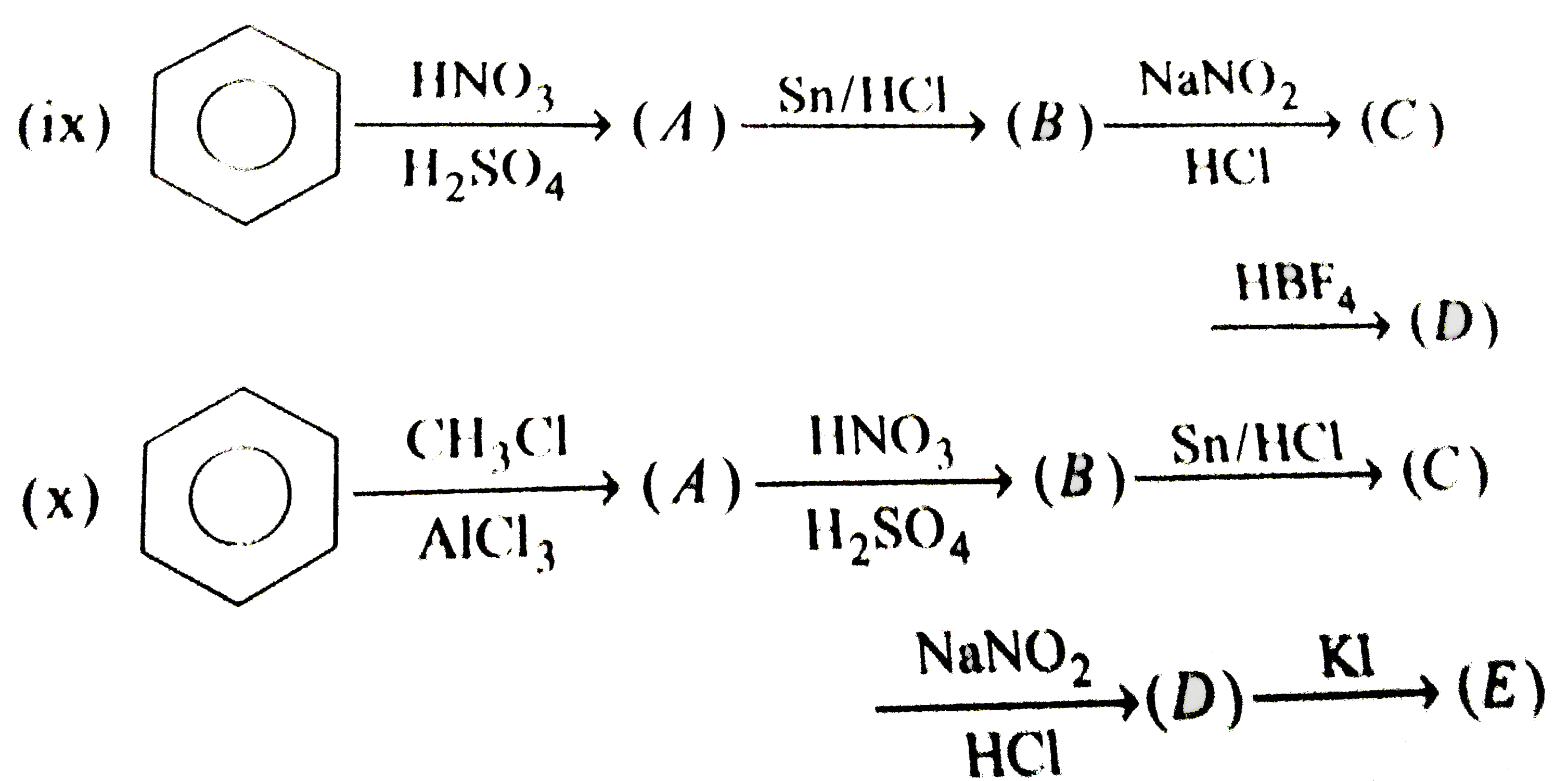Complete the following by suppling intermediates
C6H5CH2CH3KMnO4−−−−−−−−−→KOH,373KANaOH+CaO−−−−−−−−−→630KB
To solve the given question, we will break down the reactions step by step.
Step 1: Identify the starting compound
The starting compound is C₆H₅CH₂CH₃, which is known as phenethyl alcohol or phenethyl.
Step 2: First reaction with KMnO₄ and KOH at 373 K
When phenethyl (C₆H₅CH₂CH₃) is treated with KMnO₄ in the presence of KOH at 373 K, it undergoes oxidation. KMnO₄ is a strong oxidizing agent, and under these conditions, the primary alcohol group (-CH₂-) is oxidized to a carboxylic acid (-COOH).
The reaction can be represented as follows:
C₆H₅CH₂CH₃ \xrightarrow{KMnO₄, KOH, 373 K} C₆H₅COOH
This intermediate compound (A) is benzoic acid (C₆H₅COOH).
Step 3: Second reaction with NaOH and CaO at 630 K
The next step involves treating the intermediate (benzoic acid) with NaOH in the presence of CaO at 630 K. This reaction is known as decarboxylation, where the carboxylic acid group (-COOH) is removed as carbon dioxide (CO₂).
The reaction can be represented as follows:
C₆H₅COOHNaOH,CaO,630K−−−−−−−−−−−→C₆H₆
The product (B) is benzene (C₆H₆).
Final Summary
Thus, the complete reaction sequence is:
1. A: C₆H₅CH₂CH₃ → C₆H₅COOH (benzoic acid)
2. B: C₆H₅COOH → C₆H₆ (benzene)
Final Answer
- A: C₆H₅COOH (benzoic acid)
- B: C₆H₆ (benzene)
---
The starting compound is C₆H₅CH₂CH₃, which is known as phenethyl alcohol or phenethyl.
When phenethyl (C₆H₅CH₂CH₃) is treated with KMnO₄ in the presence of KOH at 373 K, it undergoes oxidation. KMnO₄ is a strong oxidizing agent, and under these conditions, the primary alcohol group (-CH₂-) is oxidized to a carboxylic acid (-COOH).
C₆H₅CH₂CH₃ \xrightarrow{KMnO₄, KOH, 373 K} C₆H₅COOH
This intermediate compound (A) is benzoic acid (C₆H₅COOH).
The next step involves treating the intermediate (benzoic acid) with NaOH in the presence of CaO at 630 K. This reaction is known as decarboxylation, where the carboxylic acid group (-COOH) is removed as carbon dioxide (CO₂).
C₆H₅COOHNaOH,CaO,630K−−−−−−−−−−−→C₆H₆
The product (B) is benzene (C₆H₆).
Thus, the complete reaction sequence is:
1. A: C₆H₅CH₂CH₃ → C₆H₅COOH (benzoic acid)
2. B: C₆H₅COOH → C₆H₆ (benzene)
- A: C₆H₅COOH (benzoic acid)
- B: C₆H₆ (benzene)
Similar Questions
Complete the following by suppling intermediates
(i) CH3CH2BrMg−−−−−→etherACH3Oh−−−→B+CView SolutionComplete the following by suppling intermediates
(i) CH3CH2BrMg−−−−−→etherACH3Oh−−−→B+CView SolutionCH3COOHNaOH−−−→[A]NaOH−−−→CaO[B]Br2−−→hv[C]
View SolutionComplete the following by suppling intermediates
CH3COOHNaOH−−−→ANaOH,Cao−−−−−−−−→630KBBr2−−−−−→hvCView SolutionCH3BrNa−−→ether[A]Br2−−→hv[B]Na−−→ether[C]
View SolutionComplete the following by suppling intermediates
CH3BrNa−−−−−→etherABr2−−−−−→hvBNa−−−−−→etherCView SolutionComplete the following by suppling intermediates
CH3CH2BrLi,ether−−−−−−→Δ[A]C̲−−→[B](CH3)2CHBr−−−−−−−−→[C]View SolutionComplete the following by suppling intermediates
CH3CH2BrLi,ether−−−−−−→Δ[A]C̲−−→[B](CH3)2CHBr−−−−−−−−→[C]View SolutionComplete the following by providing (A),(B),(C) and (D) :
(i)CH3CH2CH2OHPBr−−→(A)alc.KOH−−−−−−→Δ
(B)HBr−−→(C)NH3−−→(D)
(ii)CH3CH2CH2Ialc.KOH−−−−−−→Δ(A)H+/H2O−−−−−→
(B)SOCI2−−−→(C)H−−−−−−→LiAIH4(D)
(iii)CH3CHBrCH3alc.KOH−−−−−−→Δ(A)HBr−−−−−−−→Peroxide
(B)Nal−−−−−−→Acetone(C)H−−−−−→Ether
(iv)CH3CH2CH=CH2NBS−−−−−→Light(A)alc.KOH−−−−−−→Δ(B)
HBr−−→(C)
(v)CH3CH2MgBrCH3CHO/H2O−−−−−−−−−→(A)HBr−−→(B)
alc.KOH−−−−−−→Δ(C)
(A)NH3−−→(B)CHCI3+KOH(alc.)−−−−−−−−−−−−−→(C)Na−−−−−−−→C2H5OH
CH3−C∣CH3H−NHCH3

(viii)CH3CH2Br(i)(CH2)6N4−−−−−−−−−−−→(ii)H2O/H+(A)NaOH−−−→(B)
(i)O3−−−−−−−−−−−→(ii)Zn/HOH(A)+(C)conc.NaOH−−−−−−−→(D)
 View Solution
View SolutionPredict the products of the following reactions :
(i) C6H5CH2CH3KMnO4/KOH−−−−−−−−−→H+
(ii) CH3COOHNH3/heat−−−−−−→View Solution

